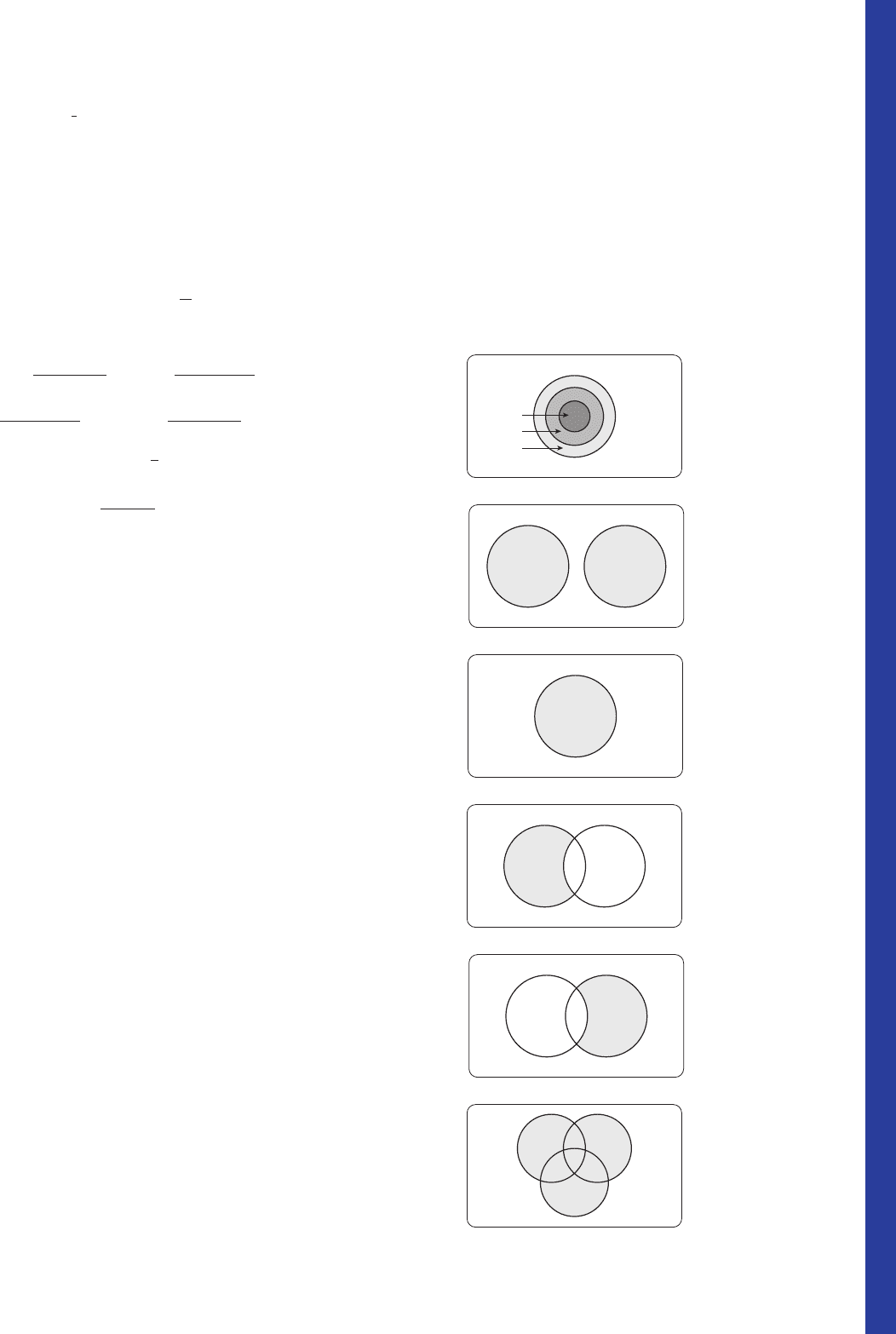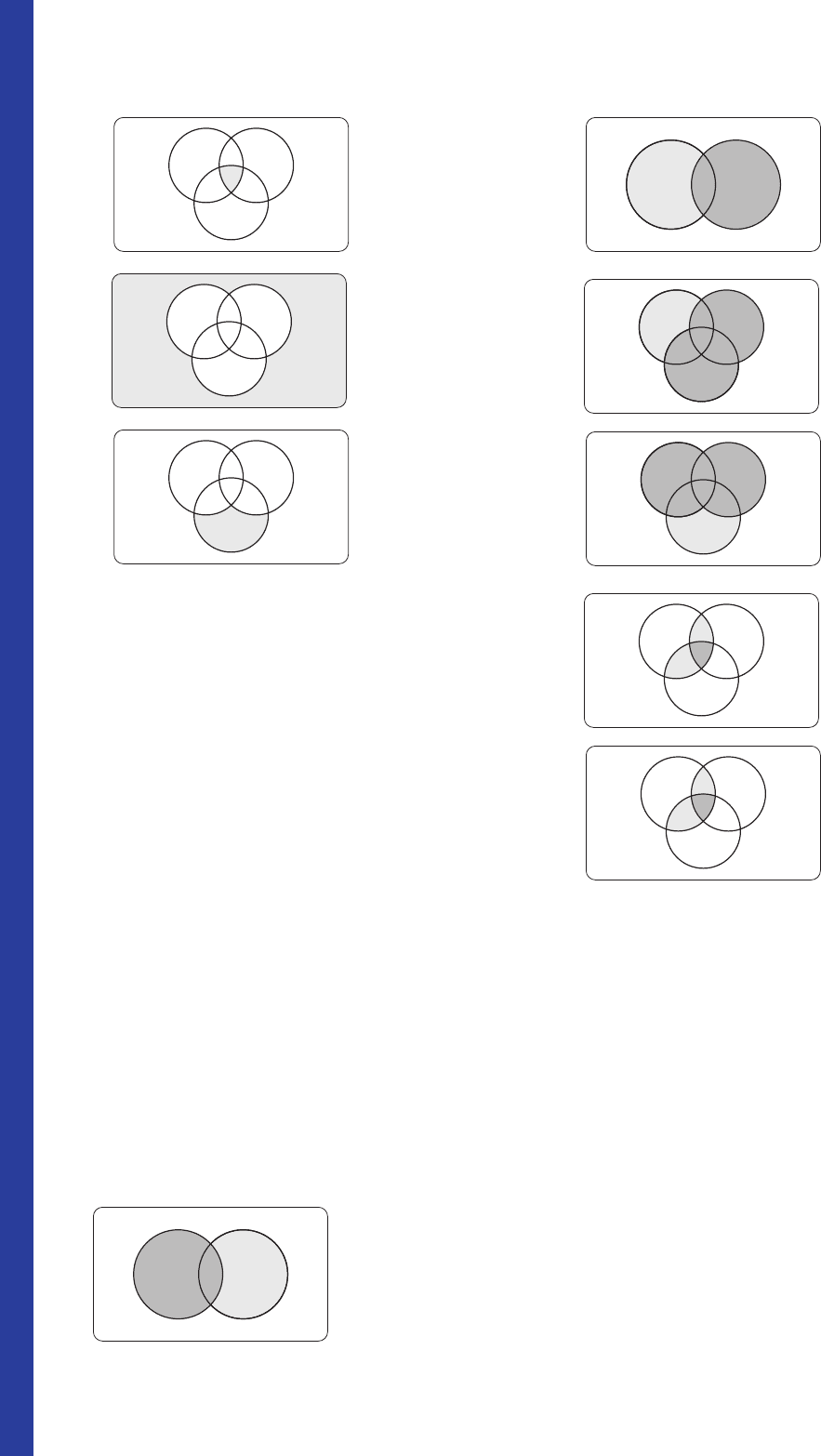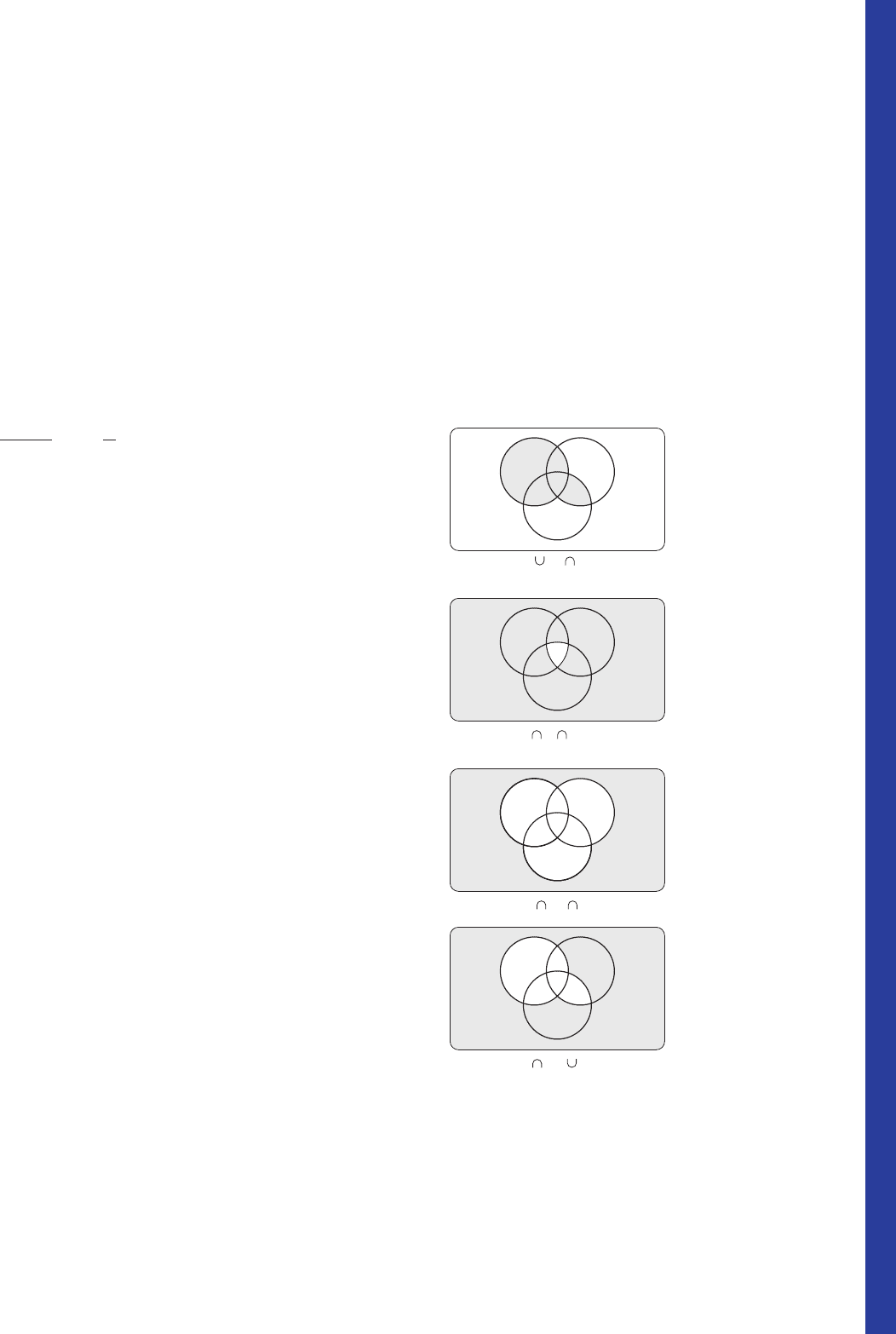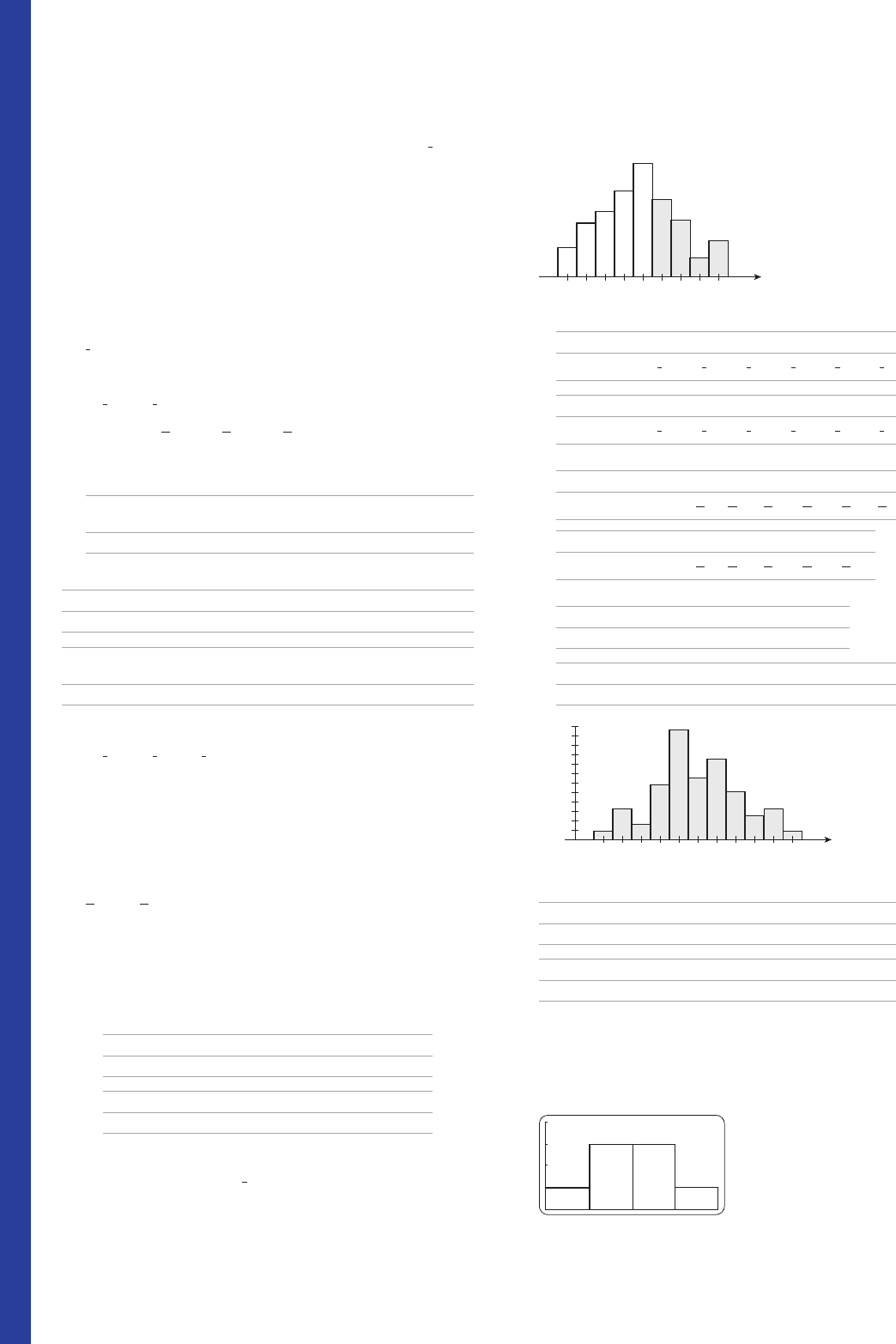Tan S.T. Finite Mathematics for the Managerial, Life, and Social Sciences
Подождите немного. Документ загружается.


7. a. x 4; y 0; C 8 b. 0 c
c. b 3 d. 2
e. Constraint 1 is binding; constraint 2 is nonbinding.
9. a. x 3; y 5; P 27 b. 2 c 5
c. 21 b 33 d.
e. The first two constraints are binding; the third is nonbinding.
11. a. 20 units of each product b. c 5
c. 216 b 405 d.
13. a. Operate Saddle Mine for 4 days, Horseshoe Mine for 6 days
b. 10,666 c 48,000 c. 300 b 1350
d. $194.29
15. a. Produce 60 of each; maximum profit of $1320
b. 8 c 15 c. 1100 b 1633
d. $0.55
e. Constraints 1 and 2 are binding; constraint 3 is not.
17. a. 120 model A and 160 model B grates; maximum profit of $480
b. 1.125 c 3 c. 600 b 1100
d. $0.20
e. Constraints 1 and 2 are binding; constraint 3 is nonbinding.
Chapter 3 Concept Review Questions, page 198
1. a. Half-plane; line b. ax by c; ax by c
2. a. Points; each b. Bounded; enclosed
3. Objective function; maximized; minimized; linear; inequalities
4. a. Corner point b. Line
5. Parameters; optimal
6. Resource; amount; value; improved; increased
Chapter 3 Review Exercises, page 198
1. Max: 18—any point (x, y) lying on the line segment joining (0, 6)
and (3, 4); min: 0
2. Max: 27—any point (x, y) lying on the line segment joining (3, 5)
and (6, 1); min: 7
3. x 0, y 4; P 20
4. x 0, y 12; P 36
5. x 3, y 4; C 26
6. x 1.25, y 1.5; C 9.75
7. x 3, y 10; P 29
8. x 8, y 0; P 48
9. x 20, y 0; C 40
10. x 2, y 4; C 14
11. x 2, y 6; C 14
12. Max: x , y ; Q ; min: x 0, y 10; Q 40
13. Max: x 22, y 0; Q 22; min: x 3,
14. Max: x 12, y 6; Q 54; min: x 4, y 0; Q 8
15. $40,000 in each company
16. 60 model A satellite radios; 60 model B satellite radios
17. 93 model A, 180 model B
18. 600 to Warehouse I and 400 to Warehouse II
y
5
2
; Q
11
2
1140
11
210
11
100
11
1
3
1
3
2
3
8
21
8
3
2
3
5
2
Chapter 3 Before Moving On, page 200
1. a.
b.
2. Min: C 7; max: P 76
3.
4. Min: x 0, y 10; C 10
5. a. Max: x 4, y 6; P 26 b. Between 1.5 and 4.5
c. Between 8 and 24 d. 1.25
e. Constraints 1 and 2 are binding.
CHAPTER 4
Exercises 4.1, page 217
1. In final form; x ,,u 0, √ 0; P
3. Not in final form; pivot element is , lying in the first row, second
column.
5. In final form; , y 0, , u 0, √ 6, w 0;
P 17
7. Not in final form; pivot element is 1, lying in the third row, second
column.
9. In final form; x 30, y 10, z 0, u 0, √ 0; P 60;
x 30, y 0, z 0, u 10, √ 0; P 60; among others
11. x 0, y 4, u 0, √ 1; P 16
13. x 6, y 3, u 0, √ 0; P 96
15. x 6, y 6, u 0, √ 0, w 0; P 60
17. x 0, y 4, z 4, u 0, √ 0; P 36
19. x 0, y 3, z 0, u 90, √ 0, w 75; P 12
21. x 15, y 3, z 0, u 2, √ 0, w 0; P 78
23. , y , z 0, u 0, √ , w 0; P 90
25. x 2, y 1, z 1, u 0, √ 0, w 0; P 87
29. No model A, 2500 model B; $100,000
31. 65 acres of crop A, 80 acres of crop B; $25,750; no
33. $62,500 in the money market fund, $125,000 in the international
equity fund, $62,500 in the growth-and-income fund; $25,625
15
4
15
2
x
5
4
z
13
3
x
1
3
1
2
220
7
y
20
7
30
7
Max: x 0, y
24
7
; P
72
7
x
4
y
4
2x 3y 15
2x y 8
x
x 3y 15
x 4
2x y 10
2 4 6 8 10 12 14 16
y
10
8
6
4
2
592 ANSWERS TO CHAPTER 4 ODD-NUMBERED EXERCISES
87533_11_ANS_p579-608 1/31/08 8:52 AM Page 592

35. 180 units of product A, 140 units of product B, and 200 units of prod-
uct C; $7920; no
37. 22 min of morning advertising time, 3 min of evening advertising
time
39. 80 units of model A, 80 units of model B, and 60 units of model C;
maximum profit: $5760; no
41. 9000 bottles of formula I, 7833 bottles of formula II, 6000 bottles of
formula III; maximum profit: $4986.60; Yes, ingredients for 4167
bottles of formula II
43. Project A: $800,000, project B: $800,000, and project C: $400,000;
$280,000
45. False 47. True
Using Technology Exercises 4.1, page 226
1. x 1.2, y 0, z 1.6, w 0; P 8.8
3. x 1.6, y 0, z 0, w 3.6; P 12.4
Exercises 4.2, page 234
1. x 4, y 0; C 8
3. x 4, y 3; C 18
5. x 0, y 13, z 18, w 14; C 111
7. , u 2, √ 3; C P 13
9. x 5, y 10, z 0, u 1, √ 2; C P 80
11. Maximize P 4u 6√
subject to u 3√ 2
2u 2√ 5; x 4, y 0; C 8
u 0, √ 0
13. Maximize P 60u 40√ 30w
subject to 6u 2√ w 6
u √ w 4; x 10, y 20; C 140
u 0, √ 0, w 0
15. Maximize P 10u 20√
subject to 20u √ 200
10u √ 150; x 0, y 0, z 10; C 1200
u 2√ 120
u 0, √ 0
17. Maximize P 10u 24√ 16w
subject to u 2√ w 6
2u √ w 8; x 8, y 0, z 8; C 80
2u √ w 4
u 0, √ 0, w 0
19. Maximize P 6u 2√ 4w
subject to 2u 6√ 30
4u 6w 12; x , y , z 0; C 26
3u √ 2w
20
u 0, √ 0, w 0
21. 2 type-A vessels; 3 type-B vessels; $250,000
23. 30 in newspaper I; 10 in newspaper II; $38,000
25. 8 oz of orange juice; 6 oz of pink grapefruit juice; 178 calories
27. True
4
3
1
3
x
5
4
, y
1
4
Using Technology Exercises 4.2, page 241
1. x 1.333333, y 3.333333, z 0; and C 4.66667
3. x 0.9524, y 4.2857, z 0; C 6.0952
5. a. x 3, y 2, P 17 b.
c. 8 b
1
24; 4 b
2
12 d. ;
e. Both constraints are binding.
7. a. x 4, y 0, C 8 b.
c. 3 b
1
; b
2
4 d. 2; 0
e. First constraint binding; second constraint non-binding
Exercises 4.3, page 251
1. Maximize P C 2x 3y
subject to 3x 5y 20
3x y 16
2x y 1
x 0, y 0
3. Maximize P C 5x 10y z
subject to 2x y z 4
x 2y 2z 2
2x 4y 3z 12
x 0, y 0, z 0
5. x 5, y 2; P 9
7. x 4, y 0; C 8
9. x 4, y ; P
11. x 3, y 2; P 7
13. x 24, y 0, z 0; P 120
15. x 0, y 17, z 1; C 33
17. x , y 0, z ; P
19. x 0, y 0, z 10; P 30
21. 80 acres of crop A, 68 acres of crop B
23. $50 million worth of home loans, $10 million worth of commercial-
development loans
25. 0 units of product A, 280 units of product B, 280 units of
product C
27. 10 oz of food A, 4 oz of food B, 40 mg of cholesterol; infinitely
many other solutions
Chapter 4 Concept Review Questions, page 254
1. Maximized; nonnegative; less than; equal to
2. Equations; slack variables; c
1
x
1
c
2
x
2
c
n
x
n
P 0;
below; augmented
3. Minimized; nonnegative; greater than; equal to
4. Dual; objective; optimal value
Chapter 4 Review Exercises, page 255
1. x 3, y 4, u 0, √ 0; P 25
2. x 3, y 6, u 4, √ 0, w 0; P 36
3. x , y 4, u , √ 0, w 0; P 19
4. x 8, y 4, u 2, √ 0, w 0; P 52
7
3
11
3
142
7
50
7
46
7
20
3
2
3
0 c
1
5
2
; 4 c
2
1
4
5
4
8
3
c
1
8;
3
2
c
2
9
2
ANSWERS TO CHAPTER 4 ODD-NUMBERED EXERCISES 593
87533_11_ANS_p579-608 1/31/08 8:52 AM Page 593

5. , y , z 0, u 0, √ 0; P
6. x 0, y , z , u , √ 0, w 0; P
7. x 2, y 2, u 0, √ 0; C 22
8. x 0, y 4, z 0, u 20, √ 0, w 20; C 12
9. Primal problem: x 2, y 1; C 9; dual problem: u , √ ;
P 9
10. Maximize P 14u 21√ 12w
subject to u 4√ 3w 2
2u √ 2w 4
u 2√ 5w 3
u 0, √ 0, w 0
11. x , y 1; C
12. x , y ; C
13. x , y 0, z ; C 60
14. x 0, y 2, z 0; C 4
15. x 45, y 0, u 0, √ 35; P 135
16. x 4, y 4, u 2, √ 0, w 0; C 20
17. x 5, y 2, u 0, √ 0; P 16
18. x 20, y 25, z 0, u 0, √
30, w 10, s 0; C 160
19. Saddle Mine: 4 days; Horseshoe Mine: 6 days; $152,000
20. $70,000 in blue-chip stocks; $0 in growth stocks; $30,000 in specula-
tive stocks; maximum return: $13,000
21. 0 unit product A, 30 units product B, 0 unit product C; P $180
22. $50,000 in stocks, $100,000 in bonds, $50,000 in money market
funds; P $21,500
Chapter 4 Before Moving On, page 256
1. xyzu√ wP Constant
211100 0 3
1 230100 1
3240010 17
1 230001
冨
0
2. x 2, y 0, z 11, u 2, √ 0, w 0; P 28
3. x 6, y 2; u 0, √ 0; P 34 4. x 3, y 0; C 3
5. x 10, y 0; P 20
CHAPTER 5
Exercises 5.1, page 269
1. $80; $580 3. $836 5. $1000 7. 146 days
9. 10%/yr 11. $1718.19 13. $4974.47
15. $27,566.93 17. $261,751.04 19. $214,986.69
21. 10
1
4
%/yr 23. 8.3%/yr 25. $29,277.61
27. $30,255.95 29. $6885.64 31. 24%/yr
33. $123,600 35. 5%/yr 37. $852.21 39. $255,256
41. $2.58 million 43. $22,163.75 45. $26,267.49
47. a. $34,626.88 b. $33,886.16 c. $33,506.76
7
4
3
4
104
11
36
11
32
11
13
2
3
2
11
10
3
10
119
6
37
6
25
6
11
3
118
5
2
5
x
56
5
49. Acme Mutual Fund 51. $23,329.48 53. $5994.86
55. $115.3 billion 57. Investment A
59. $33,885.14; $33,565.38 61. $151,718
65. 4.2% 67. 5.83% 69. True 71. True
73. 2.2 yr 75. 7.7 yr 77. 6.08%/yr 79. 2.06 yr
Using Technology Exercises 5.1, page 276
1. $5872.78 3. $475.49 5. 8.95%/yr
7. 10.20%/yr 9. $29,743.30 11. $53,303.25
Exercises 5.2, page 283
1. $15,937.42 3. $54,759.35 5. $37,965.57
7. $137,209.97 9. $28,733.19 11. $15,558.61
13. $15,011.29 15. $109,658.91 17. $455.70
19. $44,526.45 21. Karen 23. $9850.12 25. $608.54
27. Between $383,242 and $469,053
29. Between $307,014 and $373,768 31. $17,887.62
33. False
Using Technology Exercises 5.2, page 287
1. $59,622.15 3. $8453.59 5. $35,607.23
7. $13,828.60
Exercises 5.3, page 294
1. $14,902.95 3. $444.24 5. $622.13
7. $731.79 9. $1491.19 11. $516.76
13. $172.95 15. $1957.36 17. $3450.87
19. $16,274.54 21. a. $212.27 b. $1316.36; $438.79
23. a. $387.21; $304.35 b. $1939.56; $2608.80
25. $1761.03; $41,833; $59,461; $124,853 27. $60,982.31
29. $3135.48 31. $242.23 33. $199.07
35. $2090.41; $4280.21 37. $24,639.53 39. $33,835.20
41. $212.77 43. $167,341.33 45. $1957.80; $257,135.23
47. a. $1681.71 b. $194,282.67 c. $1260.11 d. $421.60
49. $1000.92 51. $71,799
Using Technology Exercises 5.3, page 299
1. $628.02 3. $1685.47 5. $1960.96
7. $894.12 9. $18,288.92
Exercises 5.4, page 306
1. 30 3. 5. 3, 8, 19, 30, 41 7. x 6y
9. 795 11. 792 13. 550
15. a. 275 b. 280 17. At the beginning of the 37th wk
19. $15.80 21. b. $800 23. GP; 256; 508 25. Not a GP
9
2
80,000e
11t/20.09t2
;
594 ANSWERS TO CHAPTER 5 ODD-NUMBERED EXERCISES
87533_11_ANS_p579-608 1/31/08 8:52 AM Page 594

27. GP; 1/3; 364
29. 3; 0 31. 293,866
33. $56,284 35. Annual raise of 8%/yr
37. a. $20,113.57 b. $87,537.38 39. $25,165.82
41. $39,321.60; $110,678.40 43. True
Chapter 5 Concept Review Questions, page 309
1. a. Original; P(1 rt) b. Interest; P(1 i )
n
; A(1 i )
n
2. Simple; one; nominal; m;
3. Annuity; ordinary annuity; simple annuity.
4. a. b.
5. 6. Future;
7. Constant
8. Constant
Chapter 5 Review Exercises, page 310
1. a. $7320.50 b. $7387.28 c. $7422.53
d. $7446.77
2. a. $19,859.95 b. $20,018.07 c. $20,100.14
d. $20,156.03
3. a. 12% b. 12.36% c. 12.5509% d. 12.6825%
4. a. 11.5% b. 11.8306% c. 12.0055% d. 12.1259%
5. $30,000.29 6. $39,999.95 7. $5557.68
8. $23,221.71 9. $7861.70 10. $173,804.43
11. $694.49 12. $318.93 13. $332.73 14. $208.44
15. 7.442% 16. 10.034% 17. $80,000
18. $2,592,702; $8,612,002 19. $5,491,922 20. $2982.73
21. $15,000 22. $5000 23. 7.6% 24. $218.64
25. $73,178.41 26. $13,026.89 27. $2000
28. a. $965.55 b. $227,598 c. $42,684
29. a. $1217.12 b. $99,081.60 c. $91,367
30. $19,573.56 31. $4727.67 32. $205.09; 20.27%/yr
33. $2203.83
Chapter 5 Before Moving On, page 311
1. $2540.47 2. 6.18%/yr 3. $569,565.47 4. $1213.28
5. $35.13 6. a. 210 b. 127.5
CHAPTER 6
Exercises 6.1, page 320
1. { is a gold medalist in the 2006 Winter Olympic Games}
3. { is an integer greater than 2 and less than 8}x 0x
x 0x
r; ar
n1
;
a11 r
n
2
1 r
d; a 1n 12d;
n
2
32a 1n 1 2d4
iS
11 i 2
n
1
Pi
1 11 i2
n
R c
1 11 i2
n
i
dR c
11 i 2
n
1
i
d
a1
r
m
b
m
1
1
3
5. {2, 3, 4, 5, 6} 7. {2}
9. a. True b. False 11. a. False b. False
13. True 15. a. True b. False
17. a. and b.
19. a. , {1}, {2}, {1, 2}
b. , {1}, {2}, {3}, {1, 2}, {1, 3}, {2, 3}, {1, 2, 3}
c. , {1}, {2}, {3}, {4}, {1, 2}, {1, 3}, {1, 4}, {2, 3}, {2, 4}, {3, 4},
{1, 2, 3}, {1, 2, 4}, {1, 3, 4}, {2, 3, 4}, {1, 2, 3, 4}
21. {1, 2, 3, 4, 6, 8, 10}
23. {Jill, John, Jack, Susan, Sharon}
25. a.
b.
c.
27. a.
b.
29. a.
U
C
A
B
U
AB
U
A
B
U
A, B, C
U
A
B
B
U
A
C
ANSWERS TO CHAPTER 6 ODD-NUMBERED EXERCISES 595
87533_11_ANS_p579-608 1/31/08 8:52 AM Page 595

b.
31. a.
b.
33. a. {2, 4, 6, 8, 10} b. {1, 2, 4, 5, 6, 8, 9, 10}
c. {1, 2, 3, 4, 5, 6, 7, 8, 9, 10}
35. a. C {1, 2, 4, 5, 8, 9} b. c. {1, 2, 3, 4, 5, 6, 7, 8, 9, 10}
37. a. Not disjoint b. Disjoint
39. a. The set of all employees at Universal Life Insurance who do not
drink tea
b. The set of all employees at Universal Life Insurance who do not
drink coffee
41. a. The set of all employees at Universal Life Insurance who drink tea
but not coffee
b. The set of all employees at Universal Life Insurance who drink
coffee but not tea
43. a. The set of all employees in a hospital who are not doctors
b. The set of all employees in a hospital who are not nurses
45. a. The set of all employees in a hospital who are female doctors
b. The set of all employees in a hospital who are both doctors and
administrators
47. a. D 傽 F b. R 傽 F
c
傽 L
c
49. a. B
c
b. A 傽 B c. A 傽 B 傽 C
c
51. a. A 傽 B 傽 C; the set of tourists who have taken the underground, a
cab, and a bus over a 1-wk period in London
b. A 傽 C; the set of tourists who have taken the underground and a
bus over a 1-wk period in London
c. B
c
; the set of tourists who have not taken a cab over a 1-wk period
in London
53.
U
AB
U
C
A
B
U
C
A
B
U
C
A
B
55.
57.
61. a. x, y, √, r, w, u b. √, r
63. a. s, t, y b. t, z, w, x, s 65. A 傺 C
67. False 69. True 71. True
Exercises 6.2, page 326
3. a. 4 b. 5 c. 7 d. 2
7. 20
9. a. 140 b. 100 c. 60
11. 13 13. 0 15. 13 17. 61
19. a. 106 b. 64 c. 38 d. 14
21. a. 182 b. 118 c. 56 d. 18 23. 30
25. a. 64 b. 10 27. a. 36 b. 36 29. 5
31. a. 62 b. 33 c. 25 d. 38
33. a. 108 b. 15 c. 45 d. 12
35. a. 22 b. 80
37. True 39. True
U
C
A
B
U
C
A
B
U
C
A
B
U
C
A
B
U
AB
596 ANSWERS TO CHAPTER 6 ODD-NUMBERED EXERCISES
87533_11_ANS_p579-608 1/31/08 8:53 AM Page 596

Exercises 6.3, page 330
1. 12 3. 64 5. 24
7. 24 9. 60 11. 1 billion 13. 5
50
15. 400 17. 9990
19. a. 17,576,000 b. 17,576,000
21. 1024; 59,049 23. 2730
25. 217 27. True
Exercises 6.4, page 344
1. 360 3. 10 5. 120
7. 20 9. n 11. 1
13. 35 15. 1 17. 84
19. 21.
23. Permutation 25. Combination
27. Permutation 29. Combination
31. P(4, 4) 24 33. P(4, 4) 24
35. P(9, 9) 362,880 37. C(12, 3) 220
39. 151,200 41. 2520
43. 20 45. C(12, 3) 220
47. C(100, 3) 161,700 49. P(6, 6) 720
51. P(12, 6) 665,280
53. a. P(10, 10) 3,628,800
b. P(3, 3)P(4, 4)P(3, 3)P(3, 3) 5184
55. a. P(20, 20) 20!
b. P(5, 5)P[(4, 4)]
5
5!(4!)
5
955,514,880
57. a. P(12, 9) 79,833,600
b. C(12, 9) 220 c. C(12, 9) ⭈ C(3, 2) 660
59. 2{C(2, 2) [C(3, 2) C(2, 2)]} 6
61. C(3,3)[C(8, 6) C(8, 7) C(8, 8)] 37
63. a. C(12, 3) 220 b. C(11, 2) 55
c. C(5, 1)C(7, 2) C(5, 2)C(7, 1) C(5, 3) 185
65. P(7, 3) C(7, 2)P(3, 2) 336
67. C(5, 1)C(3, 1)C(6, 2)[C(4, 1) C(3, 1)] 1575
69. 10C(4, 1) 40
71. C(4, 1)C(13, 5) 40 5108
73. 13C(4, 3) ⭈ 12C(4, 2) 3744
75. C(6, 2) 15
77. C(12, 6) C(12, 7) C(12, 8) C(12, 9)
C(12, 10) C(12, 11) C(12, 12) 2510
79. 4! 24 83. True 85. True
Using Technology Exercises 6.4, page 349
1. 1.307674368 10
12
3. 2.56094948229 10
16
5. 674,274,182,400 7. 133,784,560
n!
2
n1n 12
2
9. 4,656,960
11. 658,337,004,000
Chapter 6 Concept Review Questions, page 350
1. Set; elements; set 2. Equal 3. Subset
4. a. No b. All 5. Union; intersection
6. Complement 7. A
c
傽 B
c
傽 C
c
8. Permutation; combination
Chapter 6 Review Exercises, page 350
1. {3} 2. {A, E, H, L, S, T }
3. {4, 6, 8, 10} 4. {4} 5. Yes
6. Yes 7. Yes 8. No
9.
10.
11.
12.
17. The set of all participants in a consumer-behavior survey who
both avoided buying a product because it is not recyclable and
boycotted a company’s products because of its record on the
environment.
18. The set of all participants in a consumer-behavior survey who
avoided buying a product because it is not recyclable and/or
voluntarily recycled their garbage.
U
C
A
B
ABC
ccc
)
(
U
C
A
c
B
c
C
c
A
B
U
C
A
B
AB C
c
)(
U
C
A
B
ABC
(
)
ANSWERS TO CHAPTER 6 ODD-NUMBERED EXERCISES 597
87533_11_ANS_p579-608 1/31/08 8:53 AM Page 597

19. The set of all participants in a consumer-behavior survey who both
did not use cloth diapers rather than disposable diapers and volun-
tarily recycled their garbage.
20. The set of all participants in a consumer-behavior survey who did not
boycott a company’s products because of its record on the environ-
ment and/or who do not voluntarily recycle their garbage.
21. 150 22. 230 23. 270 24. 30 25. 70 26. 200
27. 190 28. 181,440 29. 120 30. 8400 31. None
32. a. 446 b. 377 c. 34 33. 720 34. 20 35. 144
36. a. 720 b. 480 37. a. 50,400 b. 5040
38. a. 60 b. 125 39. 108 40. 30 41. 80
42. a. 1287 b. 288 43. 720 44. 1050
45. a. 2704 b. 2652
46. a. 5040 b. 3600
47. a. 487,635 b. 550 c. 341,055
48. a. 1365 b. 1155
49. a. 720 b. 72 c. 48 50.
a. 495 b. 210 c. 420
Chapter 6 Before Moving On, page 352
1. a. {d, f, g} b. {b, c, d, e, f, g} c. {b, c, e}
2. 3 3. 15 4. 264 5. 200
CHAPTER 7
Exercises 7.1, page 359
1. {a, b, d, f }; {a} 3. {b, c, e}; {a} 5. No 7. S
9. 11. Yes 13. Yes 15. E 傼 F 17. G
c
19. (E 傼 F 傼 G)
c
21. a. {(2, 1), (3, 1), (4, 1), (5, 1), (6, 1), (3, 2), (4, 2), (5, 2), (6, 2),
(4, 3), (5, 3), (6, 3), (5, 4), (6, 4), (6, 5)}
b. {(1, 2), (2, 4), (3, 6)}
23. , {a}, {b}, {c}, {a, b}, {a, c}, {b, c}, S
25. a. S {B, R} b. , {B}, {R}, S
27. a. S {(H, 1), (H, 2), (H, 3), (H, 4), (H, 5), (H, 6), (T, 1),
(T, 2), (T, 3), (T, 4), (T, 5), (T, 6)}
b. {(H, 2), (H, 4), (H, 6)}
29. a. No b. No
31. S {ddd, ddn, dnd, ndd, dnn, ndn, nnd, nnn}
33. a. {ABC, ABD, ABE, ACD, ACE, ADE, BCD, BCE, BDE, CDE}
b. 6 c. 3 d. 6
35. a. E
c
b. E
c
傽 F
c
c. E 傼 F
d. (E 傽 F
c
) 傼 (E
c
傽 F )
37. a. b. c.
39. a. S {0, 1, 2, 3, . . . , 10} b. E {0, 1, 2, 3}
c. F {5, 6, 7, 8, 9, 10}
41. a. S {0, 1, 2, . . . , 20}
b. E {0, 1, 2, . . . , 9} c. F {20}
47. False
5t 0 t 265t 0 0 t 265t 0 t 06
Exercises 7.2, page 367
1. {(H, H)}, {(H, T)}, {(T, H)}, {(T, T)}
3. {(D, m)}, {(D, f )}, {(R, m)}, {(R, f )}, {(I, m)}, {(I, f )}
5. {(1, i)}, {(1, d )}, {(1, s)}, {(2, i)}, {(2, d )}, {(2, s)}, . . . ,
{(5, i)}, {(5, d )}, {(5, s)}
7. {(A, Rh
)}, {(A, Rh
)}, {(B, Rh
)}, {(B, Rh
)},
{(AB, Rh
)}, {(AB, Rh
)}, {(O, Rh
)}, {(O, Rh
)}
9. Grade ABCDF
Probability .10 .25 .45 .15 .05
11. Falling Staying Increasing Don’t
Answer behind even faster know
Probability .40 .44 .12 .04
13. Opinion Favor Oppose Don’t know
Probability .47 .46 .07
15.
Event ABCDE
Probability .026 .199 .570 .193 .012
17. a. S {(0 x 200), (200 x 400),
(400 x 600), (600 x 800),
(800 x 1000), (x 1000)}
b. Cars, x Probability
0 x 200 .075
200 x 400 .1
400 x 600 .175
600 x 800 .35
800 x 1000 .225
x 1000 .075
19. .469
21. a. .856 b. .144 23. .46
25. a. b. c. 27.
29. a. .633 b. .276 31. a. .35 b. .33
33. .530 35. a. .4 b. .23
37. a. .448 b. .255 39. .783
41. There are six ways of obtaining a sum of 7.
43. No 45. a. b. c. 1 47. True
Exercises 7.3, page 376
1. 3. 5.
1
7.
9. 11. 13. .002; .998
15. P(a) P(b) P(c) 1
17. Since the five events are not mutually exclusive, Property (3) cannot
be used; that is, he could win more than one purse.
19. The two events are not mutually exclusive; hence, the probability of
the given event is .
21. E
C
傽 F
C
{e}
1
6
1
6
1
36
11
36
12
13
3
13
1
52
1
9
1
36
1
2
5
6
1
6
3
8
1
13
1
2
1
4
598 ANSWERS TO CHAPTER 7 ODD-NUMBERED EXERCISES
87533_11_ANS_p579-608 1/31/08 8:53 AM Page 598

23. P[(G 傼 C
c
)] 1 P(G) P(C ); he has not considered the case in
which a customer buys both glasses and contact lenses.
25. a. 0 b. .7 c. .8 d. .3
27. a. b. c. d. 29. .332
31. a. .24 b. .46 33. a. .16 b. .38 c. .22
35. a. .41 b. .518 37. a. .52 b. .34
39. a. .439 b. .385 41. b. .52 c. .859
43. a. .90 b. .40 c. .40
45. a. .6 b. .332 c. .232 d. .6
49. True 51. False
Exercises 7.4, page 386
1. 3.
5. P(E) 13C(4, 2)/C(52, 2) ⬇ .059
7. C(26, 2)/C(52, 2) ⬇ .245
9. [C(3, 2)C(5, 2)]/C(8, 4) 3/7
11. [C(5, 3)C(3, 1)]/C(8, 4) 3/7 13. C(3, 2)/8 3/8
15. 1/8 17. C(10, 6)/2
10
⬇ .205
19. a. C(4, 2)/C(24, 2) ⬇ .022
b. 1 C(20, 2)/C(24, 2) ⬇ .312
21. a. C(6, 2)/C(80, 2) ⬇ .005
b. 1 C(74, 2)/C(80, 2) ⬇ .145
23. a. .12; C(98, 10)/C(100, 12) ⬇ .013
b. .15; .015
25. [C(12, 8)C(8, 2) C(12, 9)C(8, 1) C(12, 10)]/C(20, 10) ⬇ .085
27. a. b. C(3, 1)/C(5, 3) .3 c. 1 C(3, 3)/C(5, 3) .9
29. 31. .0001 33. .1 35. 40/C(52, 5) ⬇ .0000154
37. [4C(13, 5) 40]/C(52, 5) ⬇ .00197
39. [13C(4, 3) ⭈ 12C(4, 2)]/C(52, 5) ⬇ .00144
41. a. .618 b. .059 43. .030
Exercises 7.5, page 398
1. a. .4 b. .33 3. .3 5. Independent
7. Independent 9. a. .24 b. .76
11. a. .5 b. .4 c. .2 d. .35 e. No f. No
13. a. .4 b. .3 c. .12 d. .30 e. Yes f. Yes
15. a. b. c. d. e. No
17. 19. Independent 21. Not independent 23. .1875
4
11
1
6
1
6
1
36
1
12
C
D
A
.3
.7
C
D
B
.3
.7
.4
.6
1
729
3
5
31
32
1
32
3
4
1
8
1
2
,
5
8
1
2
,
3
8
25. a. b. 27. a. b. 29. .25 31.
33. a.
b. .24 c. .3984
35. a. .16 b. .424 c. .1696
37. a. .092 b. .008
39. a. .28; .39; .18; .643; .292 b. Not independent
41. Not independent 43. .0000068 45. a. b.
47. 3 51. 1 55. False 57. True
Exercises 7.6, page 406
1.
3. a. .45 b. .2222 5. a. .48 b. .33
7. a. .08 b. .15 c. .348
9. a. b. c. d.
11. 13.
15.
17. 19. .422 21. a.
b. 23. .125 25. .407
27. a. .543 b. .545 c. .455 29. .377
31. a. .297 b. .10 33. .856 35. a. .57 b. .691
37. .647 39. .172 41. .301
43. a. .763 b. .276 c. .724
45. a. .4906 b. .62 c. .186 47. .927
2
9
3
4
9
17
W
W
B
B
W
B
1
3
4
9
5
9
2
3
2
5
3
5
4
51
4
17
3
14
1
18
1
4
1
12
D
D
c
A
B
C
.57
.43
P
(
A
) = .35
P
(
C
) = .30
D
.71
.29
D
.33
.67
P(B) = .35
D
c
D
c
1
5
7
10
R
r
P
A
.38
.64
.36
N
.58
.04
R
r
.24
N
.16
.60
1
7
1
3
1
21
4
9
4
9
ANSWERS TO CHAPTER 7 ODD-NUMBERED EXERCISES 599
P Professional
A Amateur
R Recovered
within 48 hr
r Recovered
after 48 hr
N Never recovered
87533_11_ANS_p579-608 1/31/08 8:53 AM Page 599

Chapter 7 Concept Review Questions, page 412
1. Experiment; sample; space; event 2. 3. Uniform;
4. Conditional 5. Independent 6. A posteriori probability
Chapter 7 Review Exercises, page 412
1. a. 0 b. .6 c. .6 d. .4 e. 1
2. a. .35 b. .65 c. .05
3. a. .53 b. .35 c. .82 d. .18
4. a. .49 b. .39 c. .48
5. 6. a. .019 b. .981 7. .364 8. No 9. .5
10. .18 11. .25 12. .06 13. .49 14. .37
15. a. b. c. No 16. a. .284 b. .984
17. .150 18. 19. 20. 21. .00018
22. .00995 23. .245 24. .510 25. .245
26.
Figures Produced
(in dozens) 30 31 32 33 34 35 36
Probability .125 0 .1875 .25 .1875 .125 .125
27.
Income, $ 0–24,999 25,000–49,999 50,000–74,999 75,000–99,999
Probability .287 .293 .195 .102
200,000
Income, $ 100,000–124,999 125,000–149,999 150,000–199,999 or more
Probability .052 .025 .022 .024
28. a. .54 b. .72 29. a. .79 b. .59
30. a. b. c. 31. a. .757 b. .243
32. a. .56 b. .4 33. .5 34. .457 35. .368
36. a. .68 b. .053 37. .32 38. .619
39. .180 40. a. .513 b. .390
Chapter 7 Before Moving On, page 415
1. 2. 3. a. .9 b. .3 4. .72 5. .308
CHAPTER 8
Exercises 8.1, page 423
1. a. See part (b)
b.
Outcome GGG GGR GRG RGG
Value 3222
Outcome GRR RGR RRG RRR
Value 1110
c. {GGG}
3. Any positive integer 5.
7. Any positive integer; infinite discrete
9. x 0; continuous
1
6
4
13
5
12
1
4
1
2
3
8
1
52
1
24
2
15
7
8
7
8
2
7
1
n
11. Any positive integer; infinite discrete
13. a. .20 b. .60 c. .30 d. 1
15.
17. a.
x 123456
P(X ⴝ x)
y 123456
P(Y ⴝ y)
b.
x ⴙ y 234567
P(X ⴙ Y ⴝ x ⴙ y)
x ⴙ y 89101112
P(X ⴙ Y ⴝ x ⴙ y)
19. a.
x 01234
P(X ⴝ x) .017 .067 .033 .117 .233
x 5678910
P(X ⴝ x) .133 .167 .100 .050 .067 .017
b.
21.
x 12345
P(X ⴝ x) .007 .029 .021 .079 .164
x 678910
P(X ⴝ x) .15 .20 .207 .114 .029
23. True
Using Technology Exercises 8.1, page 427
Graphing Utility
1.
x
012345678910
.2
.1
1
36
2
36
3
36
4
36
5
36
6
36
5
36
4
36
3
36
2
36
1
36
1
6
1
6
1
6
1
6
1
6
1
6
1
6
1
6
1
6
1
6
1
6
1
6
x
12 13 14 15 16 17 18 19 20
600 ANSWERS TO CHAPTER 8 ODD-NUMBERED EXERCISES
87533_11_ANS_p579-608 1/31/08 8:53 AM Page 600

3.
Excel
1.
3.
Exercises 8.2, page 436
1. a. 2.6
b.
x 01234
P(X ⴝ x) 0.1.4.3.2
; 2.6
3. 0.86 5. $78.50 7. 0.91
9. 0.12 11. 1.73 13. 5.16%
15. 39¢ 17. $50 19. $118,800
21. City B 23. Company B 25. 2.86%
27. 5.3¢ 29. 2.7¢ 31. 2 to 3; 3 to 2
33. .4 35. 37.
39. a. Mean: 74; mode: 85; median: 80 b. Mode
41. 3; close 43. 16; 16; 16 45. True
Exercises 8.3, page 446
1. 2, Var(X) 1, 1
3. 0, Var(X) 1, 1
5. 518, Var(X) 1891, ⬇ 43.5
7. Figure (a) 9. 1.56
11. 4.5, Var(X) 5.25
5
14
7
12
0.25
0.2
0.15
0.1
0.05
0
21 3 4 5 6 7 8 9 10 11
Histogram
Probability
X
0.4
0.3
0.2
0.1
0
1234
Probability
Histogram
X
13. a. Let X the annual birthrate during the years 1991–2000
b.
x 14.5 14.6 14.7 14.8 15.2 15.5 15.9 16.3
P(X ⴝ x) .2 .1 .2 .1 .1 .1 .1 .1
c. 15.07, Var(X) 0.3621, ⬇ 0.6017
15. a. Mutual fund A: $620, Var(X) 267,600;
Mutual fund B: $520, Var(X) 137,600
b. Mutual fund A
c. Mutual fund B
17. 1
19. $339,600; Var(X) 1,443,840,000; ⬇ $37,998
21. 95.3%; 0.5% 23. 48%; 13.9% 25. 207.2 billion; 4.5 billion
27. 1607; ⬇ 182
29. 5.452; ⬇ 0.1713
31. 16.88 million; 0.68 million
33. a. At least .75
b. At least .96
35. 7 37. At least
39. At least 41. True
Using Technology Exercises 8.3, page 452
1. a.
b. 4,
⬇ 1.40
3. a. b. 17.34,
⬇ 1.11
5. a. Let X denote the random variable that gives the weight of a carton
of sugar.
b.
x 4.96 4.97 4.98 4.99 5.00 5.01
P(X ⴝ x)
x 5.02 5.03 5.04 5.05 5.06
P(X ⴝ x)
c. ⬇ 5.00; ⬇ 0.03
7. a. b. 65.875; 1.73
1
30
1
30
4
30
3
30
3
30
5
30
1
30
1
30
4
30
4
30
3
30
15
16
7
16
ANSWERS TO CHAPTER 8 ODD-NUMBERED EXERCISES 601
87533_11_ANS_p579-608 1/31/08 8:53 AM Page 601
